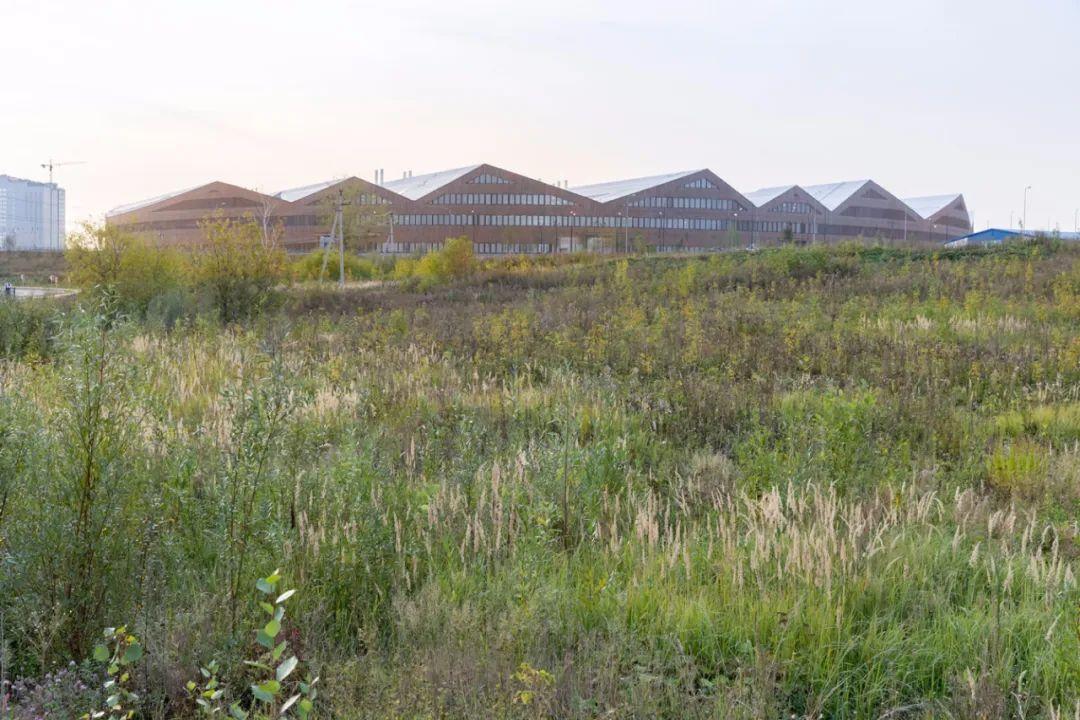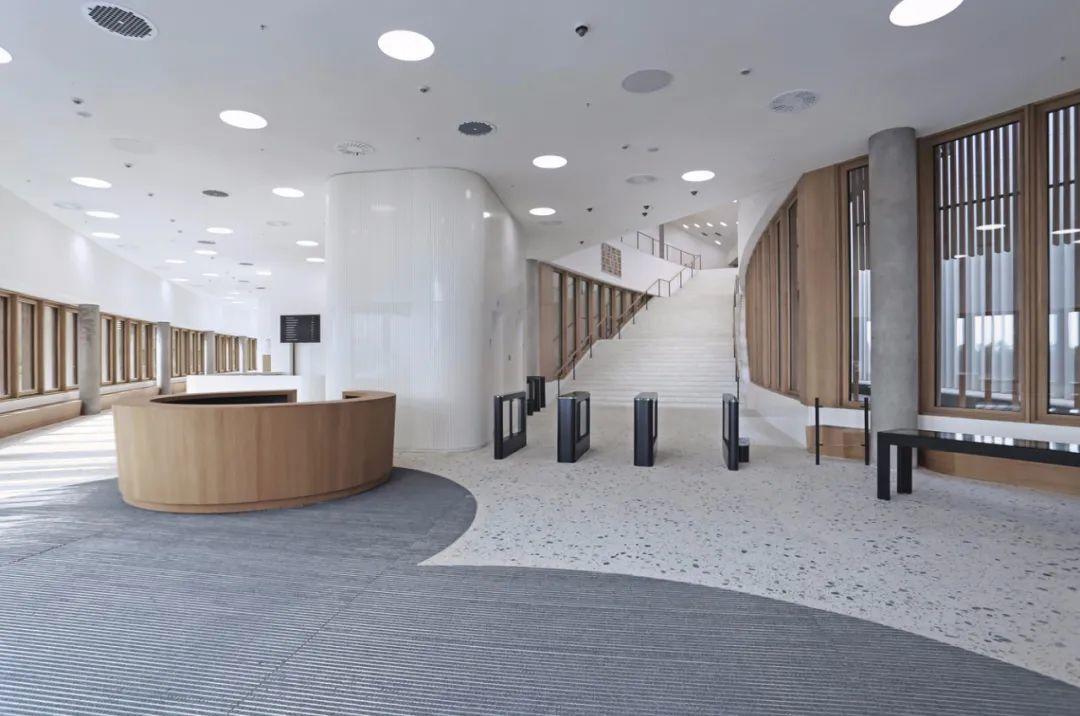
项目地点 俄罗斯莫斯科
设计单位 赫尔佐格与德梅隆
建筑面积 133979平方米
建成时间 2018
项目在斯科尔科沃,莫斯科的一个新城市社区。这里旨在建立一个国际化的21世纪创新研发中心,用于研究和生产,提供给成熟和新兴的公司、学校、研究所,以及一所新的大学使用。该社区以五个独立区为核心,嵌入如画的风景中,如同岛屿一般。每一区有不同的的形状和功能,由不同建筑师设计,使其各具特色。
Skolkovo is the Russian government initiative for a new urban community at the 3rd ring of Moscow. Built ex nihilo, the aim of Skolkovo is to create a globally reputed centre for innovative 21st century technology, embracing research and production, with administrative headquarters for both established and emerging companies, schools, institutes, and a new university. The urban scheme develops around the idea of five individual Districts, like urban islands, inserted in the picturesque landscape. Each of the five Districts has a singular shape, a specific program mix and is designed by a different architect, giving it a specific character and atmosphere.
该事务所的设计是第三区的概念性整体规划,以斯科尔科沃大学为核心,分阶段建设三个环形建筑——大学的东环、集市和西环。
Herzog & de Meuron designed the conceptual master plan of District 3. Comprised of three circular shapes and phases – the East Ring, the Agora and the West Ring – the emerging Skoltech University is envisioned as a nucleus, a distinctive core of the District and a founding stone of Skolkovo.

该项目是整体规划中的东环,形式和组织结构简单,由相扣的环形体块和矩形体块组成。低矮的层高、内部大量的开间、一系列的公共庭院,以及传统材料的使用,形成了该项目的整体性、多样性、可渗透性和纪念性。
The University East Ring has a simple form and organization of interlocked circular rings and rectangular blocks, which directly reflect its programmatic content and diversity. Skoltech is integrated, permeable, and monumental at the same time, by virtue of its low-rise architecture, numerous openings and views on the interior, a series of publically accessible courtyards, and traditional materials.

一个直径280米的外环和两个较小的内环,承载了所有共享的学术设施和公共空间。弧形的形状将所有区域连接。外环是教员办公、行政和会议空间,内环则是教学和学习空间,主礼堂位于中心交叉点。
An outer ring of 280 metres diameter and two smaller inner rings host all the shared academic facilities and public spaces. The curved shapes connect all zones in a single loop. The outer ring accommodates the faculty offices, administration and meeting spaces, while the inner rings house the teaching and learning spaces, with the main auditorium at the central crossing point.



圆环中插入以7×7米的网格形式为基础布置的矩形体块,其长度不等,宽度为21米或28米,用于容纳与学术研究活动相关的实验室和研讨室。为了优化日照,这些体块均设计为东西向。
A rational grid of rectangular and repetitive blocks is laid out in a checkerboard pattern to house laboratories and workshops related to the academic research activities. To optimize daylight the blocks are oriented east-west. The lab blocks are based on a 7 by 7 metre planning and structural grid, and have uniform widths of 21 or 28 metres, with varying lengths.


这些重复的矩形体块展示了合理高效的模块化布局,并提供了实验室和研讨室空间所需的灵活性和适应性。其他研究设施、装载、后勤和技术区域位于整个建筑的地下一层,一个连续贯通的大空间。实验室和研讨室空间使大学的学术设备更加完善,提供了一个各部门相互联系、共享的平台。
These repetitive orthogonal shapes offer the efficiency and simplicity of rational modular layouts, combined with the flexibility and adaptability generally required for laboratory and workshop spaces. Additional research facilities, loading, logistics, and technical areas are located in the continuous basement floor beneath the entire building. The laboratories and workshops complete the University’s academic area, forming a platform for interconnected departments and shared facilities.


环与块之间叠加、互动,形成了有趣的建筑特征。三个圆环贯穿每个矩形体块,将整个建筑群连接在一起,形成了一个独特的建筑形式,并且在建筑内围合出了内部庭院。尽管建筑外观看起来是统一的,但对外有许多开口,使庭院对外开放,供公众使用。
The overlay and interaction between the blocks and rings create an interesting architectural quality. The three rings circumscribe and penetrate the blocks and connect the compound together into a distinctive sculptural form, which shapes the Boulevard at the outside and creates a network of connected courtyards inside. Despite its monolithic appearance, the building is porous at street level and all its courtyards are open and accessible to the public.

最大的中央庭院可以从所有环形体块和大部分矩形体块中看到,是举行正式仪式或者日常休闲的主要场所。各个院子大小不一,通过各种廊道相连。这些廊道有的从环形体块中穿过,有的从矩形体块角落里出来,将所有外部入口连接起来。庭院里和建筑周围种植了统一的绿植,将大学景观与莫斯科周边自然森林环境融为一体。
The largest of the courtyards – the Central Yard – is visible from all the rings and most of the blocks, and is a main destination for formal ceremonies and everyday relaxation. The courtyards have diverse sizes and are connected via similarly varied passages, which either pass under the rings or carve through the corners of the blocks, offering a multitude of paths through the University, and accommodating all public entrances into the building. The uniform planting of the courtyards and around the East Ring, will become an essential element of the experience of Skoltech as it matures, and will integrate the University landscape with the natural forests around Moscow.


环形和矩形体块都覆盖以鳍状表皮,在统一立面的同时,很好地控制了光线。饰面材料则将圆环和体块区分开。环形体块内部采用天然橡木地板和墙面,外部采用西伯利亚落叶松作饰面。而矩形体块内部采用工业乙烯地板和铝制墙面,外部采用白色铝制饰面。建筑外墙由底部连续的混凝土台面和顶部相连的倾斜屋顶统一起来,与整体的外立面一起,将所有的元素整合成一个整体,使项目与总体规划中的其他建筑既互相区分,又很好地融合在一起。
The University rings and blocks are clad with fins that control the daylight and unify the facades. Finish materials distinguish the rings and blocks on the inside and outside. The rings have natural oak floor and wall systems in the interior, and Siberian larch fins on the exterior, while the blocks have industrial vinyl floor and aluminum wall systems in the labs, and white aluminum fins on the exterior. The building envelope is unified by a continuous concrete bench at the base and by connected sloping roofs at the top which, along with the overall facade, bring together all the elements into one integrated whole and set the University apart from the other buildings in the master plan. The scheme nonetheless remains fully integrated with its surroundings.


设计图纸 ▽





完整项目信息
Name: Skolkovo Institute of Science and Technology, East Ring
Location: Moscow, Russia
Herzog & de Meuron Team: Partners: Jacques Herzog, Pierre de Meuron, Stefan Marbach (Partner in Charge)
Project Team: Tomislav Dushanov (Associate, Project Director), Tobias Winkelmann (Associate, Project Director), Olga Bolshanina (Associate, Project Manager), Ilia Tsachev (Project Manager)
Farhad Ahmad (Visualisations), Florian Becker, Marcelo Bernardi, Mathieu Bujnowskyj, Ignacio Cabezas, Delphine Camus, Massimo Corradi (Digital Technologies), Blazej Piotr Czuba, Inga Federe, Diogo Figueiredo, Stefan Goeddertz (Associate), Volker Jacob, Vasilis Kalisperakis (Visualisations), Artem Kitaev, Petr Khraptovich, Christina Liao (Digital Technologies), Osma Lindroos, Áron Lőrincz (Visualisations), Bruno de Ameida Martins (Visualisations), Udayan Mazumdar, David Gonçalves Monteiro, Mònica Ors Romagosa, Argel Padilla Figueroa, Martina Palocci, Felipe Pecegueiro (Digital Technologies), Svetlin Peev, Beatriz Pérez Pérez de Iriarte, Vesna Petrovic, Pedro Polónia, Martin Raub, Elias Sanez, Harald Schmidt, Leonid Slonimskiy, Jan Skuratowski, Kai Strehlke (Digital Technologies), Alexander Stern, Ida Sze, Raha Talebi, Raúl Torres Martín (Visualisations), Miruna Tutoveanu, Maria Vega Lopez, Toru Wada, Liang Wang, Jean-Paul Willemse, Zeng Zhibin
Acoustics: Ove Arup & Partners International ltd., London, UK
Catering Consultant: LLC ‘EQ-VIP’, Moscow, Russia
Façade Engineering: Emmer Pfenninger Partner AG, Munchenstein, Switzerland
Laboratory Techniques Consultant: Payette, Boston, USA
Lighting Consultant: Ove Arup & Partners International ltd., London, UK
Sustainability Consultant: Ove Arup & Partners International ltd., London, UK
Traffic Consultant: Ove Arup & Partners International ltd., London, UK
Vertical Transportation: Ove Arup & Partners International ltd., London, UK
Fire Protection: LLC ‘MPB-group’, Moscow, Russia
Logistics Consultant: Ove Arup & Partners International ltd., London, UK
General Contractor: AO Putevi Uzice, Moscow, Russia
Client: LLC UDPC Skolkovo, Moscow, Russia
Client Representative: Mr. Alexey Savchenko
本文由Herzog & de Meuron授权有方发布,欢迎转发,禁止以有方编辑版本转载。
上一篇:蓝色模块空间:Qkids久趣/英语中心厦门店 / Crossboundaries
下一篇:福斯特事务所新办公项目动工,三维网格创造活力空间